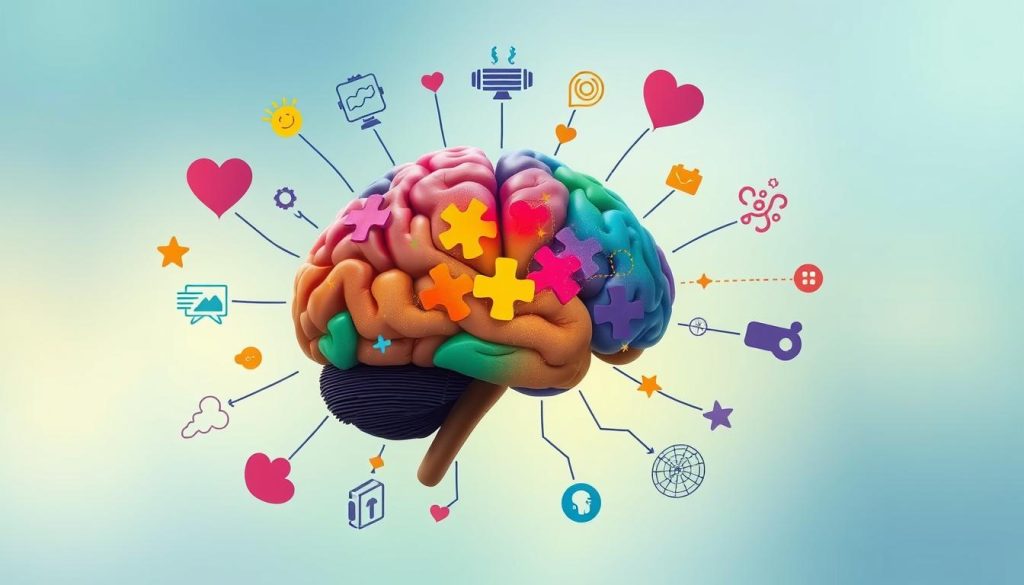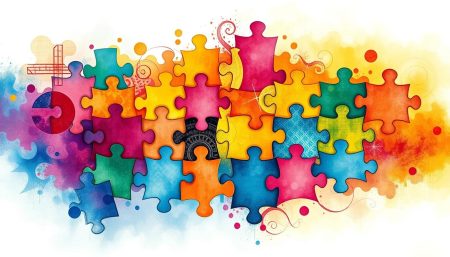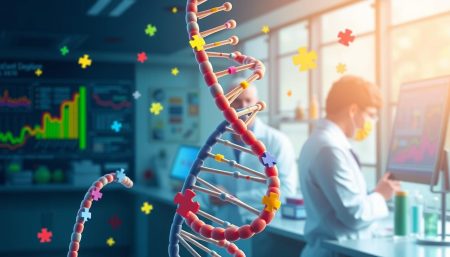The Diagnostic and Statistical Manual of Mental Disorders, 5th Edition (DSM-5) is key for health experts in the U.S. It sets the standard for mental health conditions. It focuses on Autism Spectrum Disorder (ASD), which affects social, communication, and behavior skills.
This knowledge is vital for doctors, researchers, and families of those with ASD. It helps them understand and support better.
The DSM-5’s criteria for ASD have changed over time. This shows a deeper understanding of the ASD community’s diversity. The DSM-5’s autism spectrum disorder diagnosis criteria help everyone speak the same language. This is key for getting help and services.
It also helps in accepting neurodiversity. This acceptance affects education, healthcare, and public policies in the U.S.
Looking into the DSM-5’s autism guidelines is important. It affects how we diagnose and treat ASD. Accurate diagnosis is key for better lives and outcomes for those with ASD.
Introduction to DSM-5 and Its Significance in Autism Diagnosis
The fifth edition of the Diagnostic and Statistical Manual of Mental Disorders (DSM-5) is a big change in diagnosing autism. The American Psychiatric Association introduced it. It gives doctors a better way to diagnose and understand autism spectrum disorders.
The DSM-5 combines different types of autism into one category called autism spectrum disorder. This change helps doctors see autism in a more complete way. It also means people with autism get the right help they need.
Using DSM-5 for autism diagnosis is very important. It shows a deeper understanding of autism’s many symptoms. Doctors now have better tools to help people with autism, leading to better care.
- Streamlined diagnosis process and criteria in DSM 5 autism spectrum disorder.
- Enhanced focus on personalized intervention.
- Improved consistency and accuracy in diagnosing autism spectrum disorder across different practitioners.
By updating diagnosis criteria and focusing on a range of severity, the DSM-5 offers a deeper understanding of autism. This ensures everyone gets the care they need to live a fulfilling life.
Key Changes from DSM-IV to DSM-5 for Autism Spectrum Disorder
The move from DSM-IV to DSM-5 brought big changes in how we diagnose autism spectrum disorder. DSM-5 autism spectrum disorder guidelines now group different criteria under one diagnosis. This makes diagnosis easier and covers more symptoms and behaviors.
One key change was merging several disorders into one category in DSM-5. This change helps by recognizing different levels of symptoms. It also focuses on social communication and repetitive behaviors in diagnosing ASD.
- Merging of Autistic Disorder, Asperger’s Syndrome, and PDD-NOS: These were once separate in DSM-IV but are now all part of ASD in DSM-5. This reduces confusion and makes diagnosis clearer.
- Introduction of severity levels: DSM-5 now has levels of severity. This helps in planning the right support and treatment for each person.
- Recognition of sensory issues: DSM-5 now includes sensory behaviors in the symptom list. This shows how common and important they are for people with ASD.
| DSM-IV Category | Change in DSM-5 | Impact on Diagnosis |
|---|---|---|
| Autistic Disorder, Asperger’s Syndrome, and PDD-NOS | Merged into Autism Spectrum Disorder | Unified diagnostic category enhances clarity and treatment alignment. |
| Severity of Disorder | Added levels of severity | Levels help specify necessary support and interventions based on individual needs. |
| Sensory Issues | Explicitly recognized as symptoms | Better recognition and accommodation in therapeutic settings. |
These updates in DSM-5 autism spectrum disorder guidelines show a deeper understanding of the disorder. They offer a more detailed framework that fits a wide range of symptoms. This clarity helps healthcare providers give better care, leading to better results for those with ASD.
Exploring the Core Symptoms of DSM-5 Autism Spectrum Disorder
It’s key to know the main symptoms of autism spectrum disorder as listed in DSM-5. This knowledge helps in doing a full dsm 5 autism spectrum disorder assessment and finding the right DSM-5 autism spectrum disorder treatment. The symptoms fall into two main groups: problems with social communication and interaction, and repetitive behaviors or interests.
Defining Social Communication and Interaction Challenges
People with autism spectrum disorder face big challenges in talking and interacting with others. These issues aren’t just about speaking; they also involve nonverbal communication and building and keeping relationships. They might have trouble with eye contact and body language, too.
Getting these details right is important for a correct dsm 5 autism spectrum disorder assessment.
Identifying Restricted and Repetitive Behaviors
The second main symptom area is about repetitive behaviors and interests. These behaviors are focused, repetitive, and often follow a strict routine. They might look like stereotyped movements, a need for strict routines, or an intense interest in something unusual.
Spotting these behaviors is key for planning the right DSM-5 autism spectrum disorder treatment.
| Symptom Category | Description | Impact on Assessment | Impact on Treatment |
|---|---|---|---|
| Social Communication and Interaction | Challenges in verbal and non-verbal communication, and understanding relationships | Focus on qualitative deficits during evaluations | Targeted social skills training and communication therapy |
| Restricted, Repetitive Behaviors | Behavioral rigidity, intense specific interests, and sensory sensitivities | Identification of behavior patterns critical for diagnosis | Behavioral interventions and structured routines |
DSM-5 Autism Spectrum Disorder Diagnosis Criteria
The autism diagnostic criteria in the DSM-5 are key to correctly identifying autism spectrum disorders. This precision affects how many people are diagnosed with these disorders. It also shapes how doctors and policymakers work together.
Components of a Complete Diagnostic Assessment
Diagnosing Autism Spectrum Disorder involves several important steps. Teams of experts like psychologists, pediatricians, and speech therapists work together. They use a variety of methods to get all the information they need.
- Detailed developmental history
- Behavioral observation
- Parent and teacher reports
- Neuropsychological testing
Understanding Severity Levels and Specifiers
The DSM-5 uses severity levels to show how much Autism Spectrum Disorder affects someone. These levels help decide how much support a person needs. Specifiers add more details, like if someone has trouble speaking or has an intellectual disability.
| Severity Level | Description |
|---|---|
| Level 1 | “Requiring support” |
| Level 2 | “Requiring substantial support” |
| Level 3 | “Requiring very substantial support” |
Age of Onset and Developmental Delays in DSM-5 Autism Spectrum Disorder
The DSM 5 autism spectrum disorder guidelines highlight the need to know when symptoms start and to spot early developmental delays. This knowledge is key for an accurate diagnosis and for starting the right treatment plans.

Doctors use developmental milestones to check if a child might have ASD, as the DSM 5 suggests. If a child is slow to talk, socialize, or learn, it might mean they need a closer look. How early these delays happen helps decide the best treatment approach, as research shows early help can make a big difference.
| Developmental Milestone | Typical Age of Achievement | Observation in ASD Cases |
|---|---|---|
| Single words | 12 months | Often delayed beyond 16 months |
| Phrase speech | 24 months | May be delayed beyond 36 months |
| Social Interaction | 24 months | Shows marked deviation from norms |
| Response to Name | 12 months | Delayed or inconsistent response |
These milestones, as outlined in the dsm 5 autism spectrum disorder guidelines, are more than just for diagnosing. They help track how well treatments work over time. By knowing when symptoms started and what delays are present, doctors can make treatments more specific to each person’s needs.
Co-occurring Conditions and Differential Diagnosis
Identifying DSM-5 autism spectrum disorder symptoms is complex. It involves understanding other conditions that can make diagnosis harder. Accurate assessment is key to tell autism apart from other conditions.
ADHD, anxiety disorders, and sensory integration disorders often happen with autism. This makes diagnosis tricky. Doctors must be able to tell these conditions apart to give the right help.
Understanding autism as a unique neurodevelopmental disorder is important. It’s different from mental health conditions. Knowing the differences is vital for accurate diagnosis. You can learn more about these differences here.
In diagnosing, several factors are important:
- Detailed patient history assessing developmental milestones and behavioral patterns
- Behavioral observations, specially in different social settings
- Reports from caregivers and educators offer a broader view
- Neurological and genetic tests help rule out other conditions
Recognizing the overlap in symptoms is a challenge. It shows the need for a detailed and multi-faceted assessment.
The table below shows some differences and similarities between autism and other conditions:
| Condition | Core Symptoms | Diagnosis Distinction |
|---|---|---|
| Autism Spectrum Disorder | Social communication challenges, restricted interests, repetitive behaviors | Must meet specific criteria outlined in DSM-5 |
| ADHD | Inattention, hyperactivity, impulsivity | Focus on attention deficit and hyperactivity, without pervasive social deficits |
| Anxiety Disorders | Fear or worry, avoidance behaviors | Emphasis on anxiety not necessarily linked to social contexts |
Being able to tell these conditions apart is critical. It affects treatment options and outcomes. This highlights the importance of accurate DSM-5 assessments.
Evidence-Based Assessment Tools for DSM-5 Autism Spectrum Disorder
Accurate diagnosis of autism spectrum disorder is key. Evidence-based tools are vital for this. They follow the autism diagnostic criteria in the DSM-5. Clinicians use these tools to find the right DSM-5 autism spectrum disorder treatment.
Critical Role of Observation and Behavioral Assessment
Observation and behavioral assessment are essential in diagnosing autism. Watching a patient in various settings is important. It shows how they interact and behave, meeting the autism criteria.
These observations are vital. They help understand a person’s social skills and behavior patterns. This is done through structured and unstructured play scenarios.
Utilization of Parent and Self-Reports in Evaluation
Self-reports from older kids and adults, along with parent reports, offer valuable insights. They help create a complete picture of a person’s strengths and challenges. These reports match what clinicians see in clinical settings with everyday experiences.
Using these tools ensures a detailed diagnosis. The DSM-5 criteria guide this process. It leads to personalized treatment plans, highlighting the need for tailored care in autism management.
Impact of Cultural and Gender Factors on DSM-5 Autism Spectrum Disorder
The DSM-5 has changed how we diagnose autism spectrum disorders (ASD). But, research shows that culture and gender also affect diagnosis. It’s key to understand these factors to ensure fair health care for everyone.
Culture and gender can change how we see and diagnose autism. For example, what’s seen as autism in one culture might be normal in another. Girls and women are often diagnosed later or less often than boys, due to how symptoms show up differently or societal biases.
Looking into these differences is vital. It helps us understand autism better and make diagnosis criteria more inclusive. This could lead to better care for people of all cultures and genders.
| Factor | Impact on Diagnosis | Suggested Adjustments |
|---|---|---|
| Cultural Norms | Varied interpretation of behaviors across cultures may lead to underdiagnosis. | Integrate culturally-sensitive training for medical professionals. |
| Gender Differences | Females often receive diagnoses later due to less obvious symptoms or bias. | Develop diagnosis criteria that recognize different symptom presentations. |
It’s important to make assessments more culturally aware. This could make ASD diagnoses more accurate. It would also help make care more inclusive for everyone, no matter their culture or gender.
DSM 5 Autism Spectrum Disorder Prevalence and Statistics
The DSM-5 autism spectrum disorder symptoms and guidelines are key for diagnosis and understanding public health. Recent data show changes in autism prevalence due to the DSM-5 autism spectrum disorder guidelines.
These numbers are vital for healthcare workers, policymakers, and schools to improve support. Here’s a closer look at the prevalence rates and statistics:
| Year | Prevalence per 1,000 Children | Comparison to Previous Year |
|---|---|---|
| 2018 | 18.5 | N/A |
| 2019 | 19.1 | Increase |
| 2020 | 21.2 | Increase |
| 2021 | 23.4 | Increase |
Studying the trends in DSM-5 autism spectrum disorder symptoms sheds light on many factors. It helps in creating better interventions and support based on current needs.
Family and Caregiver Perspectives on DSM-5 Diagnosis
Understanding and adjusting to an autism spectrum disorder (ASD) diagnosis under the DSM-5 is a big step for families and caregivers. This part talks about the emotional, social, and financial changes they face after getting a diagnosis. It shows how important an accurate DSM-5 autism spectrum disorder assessment and knowing the autism diagnostic criteria are for their experiences.

Getting a diagnosis based on the DSM-5 autism diagnostic criteria can be both relieving and worrying. Families are glad to understand their child’s behaviors but also worry about the future. The accuracy and detail of the DSM-5 autism spectrum disorder assessment are key. A detailed diagnosis helps families know their experiences are recognized and can be managed with the right support.
- Emotional Impact: Families often feel a mix of relief, confusion, and worry. Parents and caregivers might feel overwhelmed by the diagnosis’s implications.
- Social Considerations: Families go through a phase where they seek acceptance and understanding. Connecting with other families facing similar issues can be very helpful.
- Financial Aspect: The costs for therapies and interventions can be a big worry. Families need affordable and good health care support.
Accepting and adjusting to a diagnosis changes family dynamics a lot. Caregivers and family members often become advocates for their child and for more ASD awareness and support.
Families dealing with a DSM-5 diagnosis find that understanding and support are key to coping and adapting. The detailed approach of the DSM-5 autism spectrum disorder assessment is vital for creating interventions that fit each person’s needs. This improves the life quality for the person with ASD and their caregivers.
DSM-5 Autism Spectrum Disorder Treatment Approaches
Understanding the treatment for Autism Spectrum Disorder (ASD) under DSM-5 guidelines is key. The dsm 5 autism spectrum disorder guidelines suggest personalized treatment plans. These plans focus on behavioral therapies and early intervention.
Integrating Behavioral Therapies in Treatment Plans
Behavioral therapies are a mainstay in DSM 5 autism spectrum disorder treatment. They aim to enhance communication, social skills, and behavior management. Applied Behavioral Analysis (ABA) is a well-known and used therapy in these plans.
The Importance of Early Intervention and Consistent Support
Early intervention is a vital part of the dsm 5 autism spectrum disorder guidelines. Starting treatment early can greatly impact development and outcomes. A team of professionals, including speech and occupational therapists, is essential for ongoing support.
| Therapy Type | Focus Area | Expected Outcomes |
|---|---|---|
| Applied Behavioral Analysis (ABA) | Behavior Modification | Improvement in social skills, communication, and learning |
| Speech Therapy | Communication Skills | Enhanced ability to express needs and understand others |
| Occupational Therapy | Sensory and Motor Skills | Better daily living and self-care skills |
Following the dsm 5 autism spectrum disorder treatment guidelines helps individuals get the right care. This care is tailored to their needs, leading to better functioning and quality of life.
Advocacy and Support Resources Following a DSM-5 ASD Diagnosis
After getting a diagnosis based on the autism spectrum disorder diagnosis criteria in DSM-5, people and their families look for help. They want to know what to do next. Knowing about the support available can really help improve their lives and help them fit in better.
Many groups and organizations help those diagnosed with autism under DSM-5. They offer important services like therapy, education, and legal help.
- Local Support Groups: They give emotional and social support to individuals and families.
- Educational Programs: These programs are made for the special learning needs of people with autism.
- Advocacy Organizations: These groups fight for better policies and more funding for autism services.
The table below shows some key organizations that help with DSM-5 autism. They offer specific support based on the criteria:
| Organization | Services Offered | Focus Area |
|---|---|---|
| Autism Speaks | Advocacy, Research Funding, Community Outreach | National & International |
| The Autism Society of America | Local Support Networks, Online Resources | National |
| Global Autism Project | Skill Development, Training for Educators | Global |
These organizations do more than just support after diagnosis. They also work to meet the changing needs of autism. By connecting with these resources, individuals and families can better handle the challenges of autism.
Navigating Educational and Social Services for Individuals with ASD
For those with DSM-5 autism spectrum disorder, knowing the symptoms and how to get help is key. This help is vital for learning and social skills. It makes a big difference in their lives.
Getting started means a detailed DSM-5 autism spectrum disorder assessment. This helps figure out what each person needs. Then, an Individualized Education Plan (IEP) is made. It outlines the special help and ways to learn best.
- Educational rights awareness to ensure compliance with the Individuals with Disabilities Education Act (IDEA)
- The role of disability coordinators and special education teachers in schools
- Advocacy for appropriate classroom adjustments and resources
It’s important for teachers and helpers to know about DSM-5 autism spectrum disorder symptoms. This way, they can give the right support. This support can be things like a quiet classroom or special ways to talk and learn.
| Service | Benefit |
|---|---|
| Specialized Educational Programs | Customized curriculum that adapts to the learning pace and style of the student |
| Speech and Language Therapy | Enhances communication abilities, empowering effective interaction |
| Behavioral Interventions | Reduces challenges and enhances coping strategies for better social integration |
| Occupational Therapy | Improves daily living and motor skills, supporting greater independence |
Using these special services can really help families. It can make a big difference in how well someone with DSM-5 autism spectrum disorder does in school. It also improves their life overall. When education plans match up with the DSM-5 autism spectrum disorder assessment, everyone wins.
Future Directions in DSM-5 Autism Spectrum Disorder Research
Looking ahead, understanding DSM-5 autism spectrum disorder treatment is key. We need to adapt to new scientific findings. This focus is on better therapies and improving autism diagnostic criteria.
Emerging Therapies and Interventions
New treatments are essential for improving DSM-5 autism spectrum disorder care. Research now focuses on personalized medicine. This means treatments are tailored to each person’s needs.
This approach aims to make treatments more effective and reduce side effects. It’s a big step away from treatments that don’t fit everyone.
- Neurofeedback techniques leveraging big data analytics
- Integration of AI-driven diagnostic tools
- Advanced biologics targeting neurological pathways
Updating Diagnostic Criteria: Ongoing Debates and Considerations
There’s a constant debate on improving autism diagnostic criteria. People from all walks of life are involved. They include doctors, researchers, and advocacy groups.
The goal is to make the criteria more precise and inclusive. This will help in diagnosing autism more accurately.
| Current Issue | Potential Change | Expected Benefit |
|---|---|---|
| Broader age of onset range | Narrower, more specific age criteria | Earlier intervention and tailored treatment plans |
| Gender bias in diagnosis | Inclusion of gender-specific markers | Reduced underdiagnosis in females |
| Non-uniform severity levels | Standardized severity scale | Consistent treatment across cases |
Conclusion: Embracing Neurodiversity and Advancing Understanding
The DSM-5 autism spectrum disorder guidelines are key to better understanding and treating ASD. This article has shown how DSM-5 has changed how we diagnose autism. It highlights the need to understand each person’s experience.
The move from DSM-IV to DSM-5 has deepened our understanding of autism. We now see autism as a spectrum with different social communication and repetitive behaviors. This change has made diagnoses more accurate and has helped us understand autism’s many forms.
In conclusion, while DSM-5 has helped us understand autism better, there’s more work to do. We need to keep advocating, researching, and supporting those with ASD. By doing so, we create a more inclusive society that values neurodiversity. The DSM-5 guidelines, along with ongoing research, will help us recognize and value the unique contributions of individuals on the spectrum.
FAQ
Q: What is the DSM-5 and why is it important for diagnosing Autism Spectrum Disorder (ASD)?
A: The DSM-5 is a guide for mental health professionals to diagnose mental disorders. It’s key for ASD diagnosis because it sets clear criteria. This ensures diagnoses are consistent and accurate everywhere.
Q: How did the criteria for diagnosing Autism Spectrum Disorder change from DSM-IV to DSM-5?
A: DSM-5 merged separate categories into one ASD diagnosis. It focuses on two main areas: social communication and repetitive behaviors. This change shows a deeper understanding of autism.
Q: What constitutes challenges in social communication and interaction under DSM-5?
A: DSM-5 defines social challenges as trouble with social-emotional reciprocity and nonverbal communication. It also includes issues in developing and keeping relationships. These are key parts of ASD diagnosis.
Q: How are severity levels and specifiers used in DSM-5 ASD diagnosis?
A: DSM-5 uses severity levels and specifiers to describe support needs. Severity levels show how much support is needed in social and repetitive behaviors. Specifiers add more details, like intellectual impairment or language delay.
Q: What is the significance of the age of onset in diagnosing ASD according to DSM-5?
A: DSM-5 says symptoms must start early, often in the first two years. Early symptoms are important for diagnosis. They also guide early intervention, which can greatly improve outcomes.
Q: What are some co-occurring conditions with ASD and how do they impact diagnosis?
A: ASD often comes with conditions like ADHD, anxiety, depression, and epilepsy. These can make diagnosis harder by adding complexity. They need careful differential diagnoses.
Q: What assessment tools are used to diagnose ASD according to DSM-5?
A: DSM-5 uses tools like the Autism Diagnostic Observation Schedule (ADOS) and the Autism Diagnostic Interview-Revised (ADI-R). Parent and self-reports are also important. They help in a full evaluation of ASD.
Q: How do cultural and gender factors impact the diagnosis of ASD?
A: Cultural and gender factors can affect how ASD symptoms are seen. They might lead to underdiagnosis or misdiagnosis in some groups. It’s vital to consider these factors for fair diagnoses.
Q: What are the latest statistics on the prevalence of ASD as per DSM-5?
A: The latest data show ASD affects about 1 in 54 children in the U.S. This rate, under DSM-5, highlights the need for more research and support for ASD individuals and their families.
Q: What treatment approaches are recommended for ASD in the DSM-5?
A: DSM-5 suggests individualized treatment plans. This may include behavioral therapies, speech and occupational therapy, and sometimes medications. Early and consistent support are key for better outcomes.
Q: What support resources are available following a DSM-5 ASD diagnosis?
A: Families can find support through autism organizations, community programs, and educational resources. These help understand ASD, navigate services, and improve life quality.
Q: How can the DSM-5 criteria for ASD evolve in the future?
A: The DSM-5 criteria for ASD may change with new research and therapies. Future updates will consider scientific progress, clinical knowledge, and diverse ASD experiences.


















